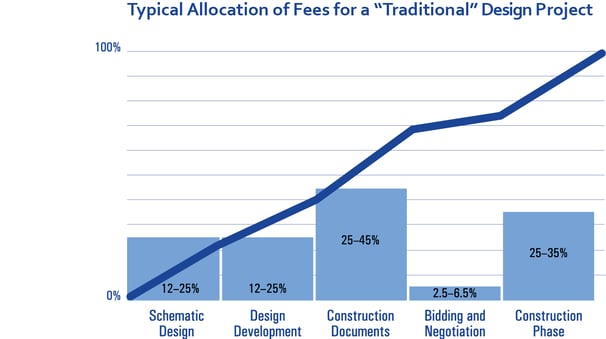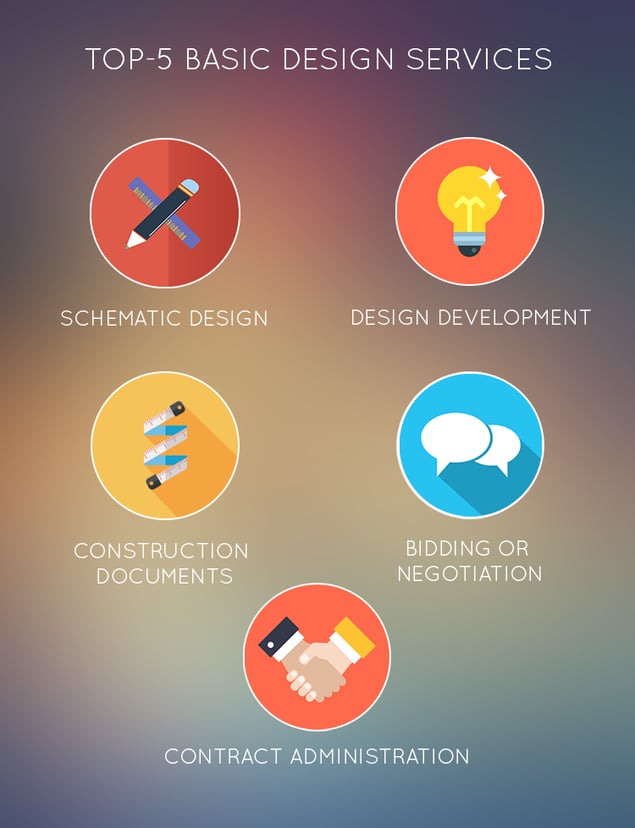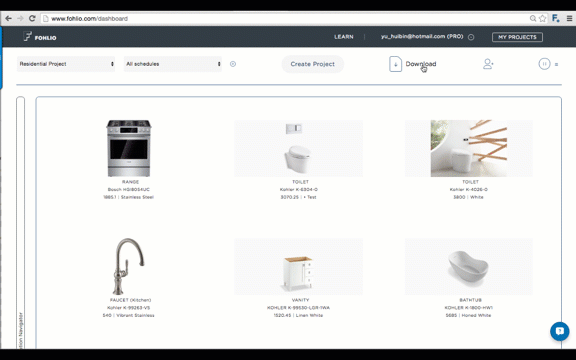
Manage FF&E specification, procurement, and product data at scale. Take on bigger projects with confidence and grow your firm with Fohlio. Schedule a demo or book a consultation with one of our account managers to explore these features today.
Following our last article, Four Must-Haves in a Great Design Proposal, let’s dig into the topic of drafting a proposal in much greater detail. Here we will focus on the most important part – Fees & Terms. Within this article we will discuss how to effectively establish a scope of work and determine the method of compensation for your proposal properly. Now fasten your seatbelt, here we go!
What Basic Design Services Should I Offer?
It is critical for the Client and the Designer/Architect to have a mutual understanding of the services required and expected. We begin this article at the beginning, outlining the basic services typically offered and the additional services that will adjust your fee.
Traditionally, the basic services offered for any project can follow a five-phased approach to design and construction
- Schematic Design
- Design Development
- Construction Documents
- Bidding or Negotiation
- Construction – Contract Administration
What Variables or Fee Adjustment Factors should I consider?

Projects nowadays are becoming increasingly complex, both in regards to the design and the construction, such that each project should be evaluated individually to assess the certain unique factors which must be considered to determine an appropriate fee and method of compensation.
-Predesign
Very often your client will not have all of the information, programmatic or otherwise, for you to even begin providing the basic services of the project. The Designer/Architect may provide these services for an additional fee (such as the preparation of a functional program, zoning study, or design brief) or arrange for the necessary consultants to prepare the work.
-Fast Track Projects and Schedule
Very frequently there is often a pressure to complete a project as soon as possible in order to occupy the building for a specific task. Fast track projects or timelines require additional fees because you may need to hire additional staff, pay staff for overtime work, and re-schedule other work to accommodate the priorities of such a project.
Another factor to consider is extended construction schedules. Because a general contractor’s schedule has a direct correlation on your own schedule, if the GC’s schedule is extended then your services also must be considered extended and this increase must be compensated for.
-Project Documentation and Computer Modeling
Many clients require unique forms of documentation. There is often a need to provide deliverables in a variety of formats to several different parties in the development of the project whether for review and approvals, the preparation of shop drawings, or for bidding purposes. This can be very time consuming to provide such a wide range of documentation.
-Consultants
The fee for the services and coordination of specialist consultants is always over and above the fee or normal percentage for the services.
-Approvals and Jurisdictions
The number of approvals from various ‘Authorities Having Jurisdiction’ continues to grow. Requirements vary by jurisdiction and by building type; therefore, the fee must be adjusted for each jurisdiction and for each building type.
-Submittals
The more frequent or detailed the submittals the more costly the effort to prepare the documentation for the submission.
-Construction Administration
Today many clients are demanding a level of service which exceeds that which is required to exercise a reasonable standard of care. This may include: additional meetings, clarifications, coordination and/or site visits resulting from the Client’s selection of specific contractors, sub-trades, suppliers and/or products.
-Project Location and Site Conditions
The project location and site conditions may affect the services also. A very tight, dense urban site or a remote site in the south can both have complications in terms of design. Furthermore, a remote site may require travel time and reimbursable expenses considerably beyond the normal.
-Renovation vs. New Construction
Renovation work is well-known for its unknown conditions. This is the reason that it is recommended that renovations to existing buildings be performed on a time basis.
-Repeat Work or Repetitive Designs
When two or more projects are designed for the same client from the same unmodified design, the fee for the Designer’s services is usually reduced by about 50% for all phases of the work, except for construction administration which remains the same.
-Stop and Start-up
On some projects it is necessary to stop work on the design or preparation of construction documents. This could be due to a delay in funding or for other circumstances. This problematic situation creates complications that can extend past the Architect/Designer to their consultants and staff on the project and must be reassigned or even released. Similarly, if a project is suddenly “back on the boards” or restarted, arrangements for staff that recommence production work on the project is necessary. Such a situation can be costly and can affect your cash flow and bottom line; therefore it is important to negotiate a fee adjustment when this occurs.
-Phased Building Occupancies
On certain very large and complex projects, building users and clients often want to occupy various parts of a building as soon as their completion. This
Methods of Compensation
The most common methods of compensation for an Architect’s and Designer’s services are:
• Fixed Fee
• Time basis
• Percentage-based Fee
Very often the project and Client are best served by a combination of these various methods of compensation rather than one single fee method. Very often, it is more appropriate to use one method of compensation for one phase of the project and a different method of compensation for another phase.
1. Fixed Fee
A fixed fee or lump sum is an amount negotiated with the Client for professional services that can be sufficiently defined at the outset of the project. This arrangement is only suitable if the scope of the project, the schedule for design and approvals, and the construction schedule and other variables can be determined with reasonable accuracy by the Architect. If project conditions and parameters change, or if the size of the project or scope of work increases or decreases, then the fee must be adjusted.
If you have a fixed-fee method of compensation, don’t forget to specify the amount of revisions within your scope of work that would be covered by the proposal. This little thing might save you plenty of nerve cells if you have a problematic client.
2. Time Basis
This type of fee, which should be agreed at the outset, relies on an hourly or daily rate and is ideal for when the services are difficult to determine or more à la carte in nature. When agreeing on time-based fee, especially if this is a large project, make sure you also establish a date for renegotiating the fee (e.g. annually) to correct for inflation or other newly arisen variables.
Please note that charging for basic services on a time-basis does not mean that the total fee for services will be any lower or reduced in comparison with the corresponding percentage-based fee.
3. Percentage Based Fee
A percentage-based fee correlates the fee for the Architect’s services to a percentage of the construction cost of the project. The percentage will vary depending on the type of building, the construction value, and the type of construction contract, and of course, the other variables (fee adjustments) described above.
Generally speaking, percentage-based fees are based on sliding scales taking into account both the size and complexity of the project and the construction cost. The sliding scales are not suitable for many renovation projects nor for very complex or custom projects.

*SOURCE: "A Guide To Determining Appropriate Fees for the Services of an Architect" By The Royal Architectural Institute of Canada
Hopefully, now you will be able to draft a proposal and determine the method of compensation easily. In the next article of this series we will dive in further into the subject of fees to help you calculate the internal costs related to each specific project so that you can be profitable. Stay tuned and subscribe to our newsletter.
Don’t forget to check out the Fohlio Smart Browser Extension tailored for Interior Designers and Architects, allowing for one-click website information grabbing for design schedules and specifications. Fohlio allows you to export this information to all the popular formats, including PDF, Excel and InDesign.
Expore Fohlio
Learn how to:
- Save days of work with faster specification
- Create firm-wide design standards
- Automate and centralize procurement
- Keep your whole team on the same Page
- Manage product data
- Track budget against cost in real time.
- Prepare for asset valuation
Published Jul 7, 2016




